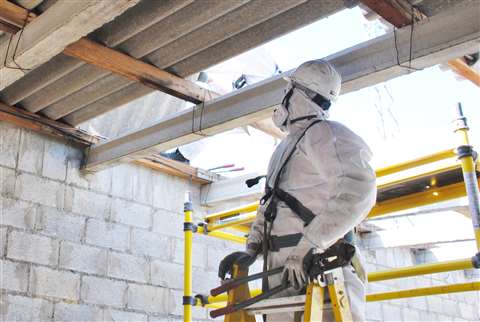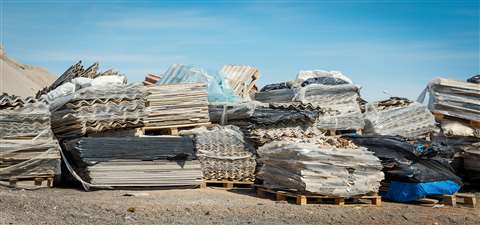Asbestos: a serious renovation headache for the European Union
06 February 2023
Before its deadly impact was recognised and its commercial use banned all over the European Union back in 2005, asbestos was widely used in building construction for decades.
 Greater contact with asbestos is an inevitable result of the EC’s focus on building renovation. Photo: Adobe Stock
Greater contact with asbestos is an inevitable result of the EC’s focus on building renovation. Photo: Adobe Stock
Nowadays, we still bare the heritage of millions of tonnes of this cancer-causing substance in our homes and workplaces. This poses a risk both to residents and mainly to construction workers in charge of demolition and/or renovation works.
The European Commission published a Communication on how to achieve an asbestos-free Europe for current and future generations.
With the expected increase in renovation works, more people and in particular more construction workers are expected to be exposed to asbestos fibres if and when released in the air and inhaled when old buildings are demolished or renovated.
EC proposals
According to the European Commission’s Communication, 78% of cancers recognised as occupational cancer in the EU are asbestos-related; 70 000 workers in the EU died from past exposure to asbestos, in 2019; 4.1 to 7.3 million workers are currently exposed to asbestos; and over 220 million building units were built before the 2005 ban.
In order to better protect people from asbestos and achieve an asbestos-free future, the European Commission puts forward proposals in 6 different areas:
- supporting victims of asbestos-related diseases,
- protecting workers against exposure to asbestos,
- addressing asbestos present in buildings,
- ensuring a safe disposal of asbestos waste and zero pollution;
- providing EU financing support to Member States for better health prevention and treatment as well as renovations and the safe removal of asbestos;
- and positioning the EU as global leader in the fight against asbestos, together with international partners, while asbestos is still extracted and commercially available in many parts of the World.
Focusing on the protection of workers, the European Commission proposed to amend the Asbestos at Work Directive to reduce the occupational exposure limit for asbestos to 10 times lower than the current value (from 0.1 fibres per cubic centimetre to 0.01 f/cm3).
 Safe asbestos waste management is another growing issue for Europe. Photo: Adobe Stock
Safe asbestos waste management is another growing issue for Europe. Photo: Adobe Stock
The European Commission argues that it would allow for a more uniform protection of workers across the EU on the basis of the latest scientific and technological developments. It would also create a level playing field for businesses and prevent higher healthcare costs for medical treatment in the future.
Employers’ obligations
Together with this revision, the European Commission will offer guidelines on implementation, as well as launch an awareness-raising campaign on the safe removal of asbestos aimed at companies, workers, owners and public administrations.
Workers’ health and safety are a top priority for companies in the construction sector. It is the obligation of the employer to exclude hazards to health and safety of workers during activities involving hazardous substances.
However, if it is not possible in practice, he must reduce hazards to a minimum. In this respect, and provided that it is based on sound scientific evidence, the construction industry adheres to the objective of pursuing constant improvement in this field.
However, focusing only on lowering the occupational exposure limit value (OEL), as it is proposed by the European Commission, will not ensure that the workers’ protection objective will be achieved in the actual circumstances. In any case, the two co-legislators – the European Parliament and the Council of the European Union – shall refrain from going lower than the target proposed by the European Commission, namely 0.01 fibres/cm3 (on an 8-hour time weighted average).
An informed workforce
Asking for a lower OEL at the EU level would not be a realistic target in the present circumstances, as construction companies would not be able to implement the requested limits.
Regardless of the measurement methodology used, a transitional period of 4 to 5 years should be ensured in the revision of the directive.
Finally, to achieve stricter objectives, construction companies will need a set of support measures, including: upgraded training to workers, financial support to upgrade technics, processes, etc., better information on asbestos present in buildings, easily accessible and affordable waste treatment facilities, as well as guidance and awareness-raising campaigns.
The European Commission announces that it will propose a new legislation on the screening and registration of asbestos in buildings, and it will encourage Member States to develop national asbestos removal strategies and to introduce digital building logbooks.
Indeed, implementing screening measures before demolishing or renovating buildings built before the (national) asbestos ban, together with a registration system, are effective ways to allow companies to take the right steps and reduce the risk of workers’ exposure to asbestos. For that purpose, clients (ie homeowners or project owners) should bear the responsibility of such screening and therefore benefit from financial incentives.
As regards the setup of a centralised and/or digital registration system, it should be under the responsibility of Member States.
In any case, the European Commission should base it future proposal on the existing national and regional schemes and avoid putting those already well-functioning systems at risk.
Managing waste
Ideally, each Member State should put in place an overall removal strategy in order to progress towards – if not an “asbestos-free” future, at least towards – an “asbestos-safe” future.
Last but not least, the management of asbestos waste and asbestos-containing waste represents a huge challenge. To tackle this, the European Commission proposes to revise the protocol and guidelines on construction and demolition waste management[1], as well as to study and identify asbestos waste management best practices.
Knowing that most of these wastes currently go to dedicated landfills, any improvement of the handling of such hazardous waste would be welcome.
Basically, construction companies need a greater availability and affordability of adapted waste facilities for asbestos at their regional/local level. Moreover, considering the amount of asbestos waste which will be collected in the near future, it is time to find more sustainable waste treatment solutions.
To learn more, visit www.fiec.eu
STAY CONNECTED



Receive the information you need when you need it through our world-leading magazines, newsletters and daily briefings.
CONNECT WITH THE TEAM







